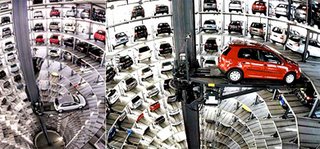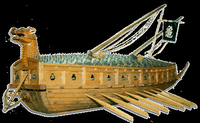
A US company called Robotic Parking systems Inc. has developed a multi million Dollar automated garage. It is quite brilliant. You drive your car onto a metal pallet structure. It then takes your car up to the next available space (be it 5 stories up) on steel wheels and tracks and lifts, slotting it in place like a huge filing system (see the picture). Before it “parks” your car, it also rotates it 180 degrees, to make it easier when you need your car again. It also uses AI to analyse trends, reshuffling cars according to customer usage, so as to reduce return times when you need your car again. It saves so much space that you can fit almost double the amount of cars that a normal parking garage can take. “Is it safe?” you ask. Well, a Jeep and a Cadillac once fell of it…! But it seems they ironed out the problem subsequently.
Here is the most amazing part: It’s run on an off-the-shelf PC with Windows NT as an operating system! It uses General Electric hardware with open source software called Simplicity.
Another positive spin-off is that it reduces car theft and robberies that normally take place in parking garages to zero, simply because drivers don’t even enter the garage. Apparently, they are looking at automating it even further, whereby as you approach the garage, a card (which you place in the windscreen) is detected by the garage’s systems, and automatically readies the pallet. Upon return, the system again recognises the card and as the driver approaches, fetches the car and gets it ready for the driver to just get in and drive off. I recall a scene from iRobot, where detective Spooner (Will Smith) parks his car (a futuristic Audi) at the pavement. The car is then taken into an automated garage, similar to what is described here! The future is here.
No more wandering around looking for your car!
PS. So as not to get sued for plagiarism, the credit for this post’s heading goes to this article.














